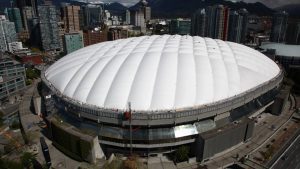Menglong Shi
55053136
In this project, our main topic is the New National Stadium which will be used as the main stadium of 2020 Olympic Games in Tokyo. The group divided the work as five main parts: The material used in the stadium, environmental impact of the stadium, economic impact of the stadium, green space of the stadium and the link to Canada. As for my part, my main focus is the link to Canada. I try to find some connection to the perspective of Canada. If they used some woods that produced in Canada or they used some technology from Canada? But I cannot find any specific information related to such aspect. I got stuck in the work. And thanks to Vancouver, who held the Winter Olympic Games in 2010. Therefore, I try to make a comparison between the New National Stadium in Tokyo and BC Place in Vancouver. Both of them are used as the main stadium of the games. I will do some more analysis and comparison in the following.

New National Stadium, (Source: www.japantimes.co.jp/news/2016/03/04/national/review-team-works-weigh-location-2020-olympics-cauldron-new-tokyo-stadium/#.WfFpdJOnFjc)
The 2010 Vancouver Winter Games just used a ready-made stadium after some simple renovations, but Japanese built the New National Stadium on the site of old National Stadium. The Capacity of BC Place is 55,000 while the New National Stadium in Tokyo is 68,000. Surely, the New National Stadium looks more fancy and up-to-date. But the construction cost is also more “fancy” than BC Place. The budget cost of the New National Stadium is 1.26 billion in US dollars, while the construction cost of BC Place is 830 million in 2016 dollars including the original construction cost 126.1 million dollars (equals to 279 million in 2016 dollars) and the cost of renovation during 2009 to 2011 (551 million in 2016 dollars).
As for the part of environmental impact, I cannot find any useful information about the EIA of BC Place. I hope this process can be more transparent and get more public participation. While we find both positive and negative impacts of the new stadium in Tokyo that will bring. For the positive part, the New National Stadium can served as a green space in the central area of Tokyo. I think it is a great legacy that 2020 Olympic games can leave to the overpopulated Tokyo. Meanwhile, in the Emma’s part, some NGOs said that the large amount wood were used in the New National Stadium may cause deforestation in the rainforest area.

BC Place in 2010 (Source:www.youtube.com/watch?v=tdTsdaZc_d8)
For the material used in the stadium. BC Place used the traditional material. It is worthy to say that BC Place replaced the original air-supported roof with a cable-support retractable roof system. But this happened a few month after the Winter Olympics in 2010. So, the Winter Games in 2010 had no chance to enjoy this new roof system. As for the New National Stadium, my group member Hugo introduced to me that large amount of timber were used. As forestry resource is a kind of reusable material. It helps to the goal of sustainable development.

BC Place in 2017 (Source: www.bcplace.com/)
As for the sustainable use, BC Place is served as home stadium for BC Lion and White Cap after the 2010 Winter Olympic Games. And we could say BC Place is a landmark for Vancouver. The sustainable usage of the New National Stadium in Tokyo after the 2020 Olympic Games could be a problem to solve in the upcoming future. If they will invite a J-League team or a NPB team to the new national stadium as a long term tenant? We will wait to see.
References:
Statistics Canada, (2017), Consumer Price Index, by Province (monthly). Retrieved October 25, 2017, from http://www.statcan.gc.ca/tables-tableaux/sum-som/l01/cst01/cpis01a-eng.htm
